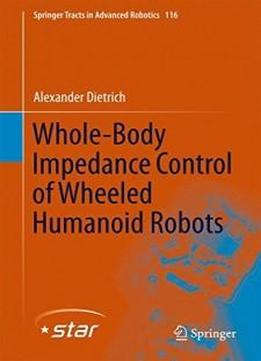
Whole-body Impedance Control Of Wheeled Humanoid Robots (springer Tracts In Advanced Robotics)
by Alexander Dietrich /
2016 / English / PDF
11.2 MB Download
Introducing mobile humanoid robots into human environments
requires the systems to physically interact and execute multiple
concurrent tasks. The monograph at hand presents a whole-body
torque controller for dexterous and safe robotic manipulation.
This control approach enables a mobile humanoid robot to
simultaneously meet several control objectives with different
pre-defined levels of priority, while providing the skills for
compliant physical contacts with humans and the environment.
Introducing mobile humanoid robots into human environments
requires the systems to physically interact and execute multiple
concurrent tasks. The monograph at hand presents a whole-body
torque controller for dexterous and safe robotic manipulation.
This control approach enables a mobile humanoid robot to
simultaneously meet several control objectives with different
pre-defined levels of priority, while providing the skills for
compliant physical contacts with humans and the environment.
After a general introduction into the topic of whole-body
control, several essential reactive tasks are developed to extend
the repertoire of robotic control objectives. Additionally, the
classical Cartesian impedance is extended to the case of mobile
robots. All of these tasks are then combined and integrated into
an overall, priority-based control law. Besides the experimental
validation of the approach, the formal proof of asymptotic
stability for this hierarchical controller is presented. By
interconnecting the whole-body controller with an artificial
intelligence, the immense potential of the integrated approach
for complex real-world applications is shown. Several typical
household chores, such as autonomously wiping a window or
sweeping the floor with a broom, are successfully performed on
the mobile humanoid robot Rollin’ Justin of the German Aerospace
Center (DLR).
After a general introduction into the topic of whole-body
control, several essential reactive tasks are developed to extend
the repertoire of robotic control objectives. Additionally, the
classical Cartesian impedance is extended to the case of mobile
robots. All of these tasks are then combined and integrated into
an overall, priority-based control law. Besides the experimental
validation of the approach, the formal proof of asymptotic
stability for this hierarchical controller is presented. By
interconnecting the whole-body controller with an artificial
intelligence, the immense potential of the integrated approach
for complex real-world applications is shown. Several typical
household chores, such as autonomously wiping a window or
sweeping the floor with a broom, are successfully performed on
the mobile humanoid robot Rollin’ Justin of the German Aerospace
Center (DLR).
The results suggest the presented controller for a large variety
of fields of application such as service robotics, human-robot
cooperation in industry, telepresence in medical applications,
space robotics scenarios, and the operation of mobile robots in
dangerous and hazardous environments.
The results suggest the presented controller for a large variety
of fields of application such as service robotics, human-robot
cooperation in industry, telepresence in medical applications,
space robotics scenarios, and the operation of mobile robots in
dangerous and hazardous environments.











